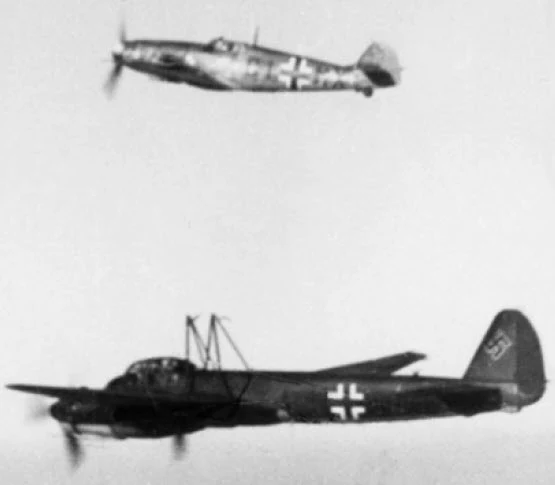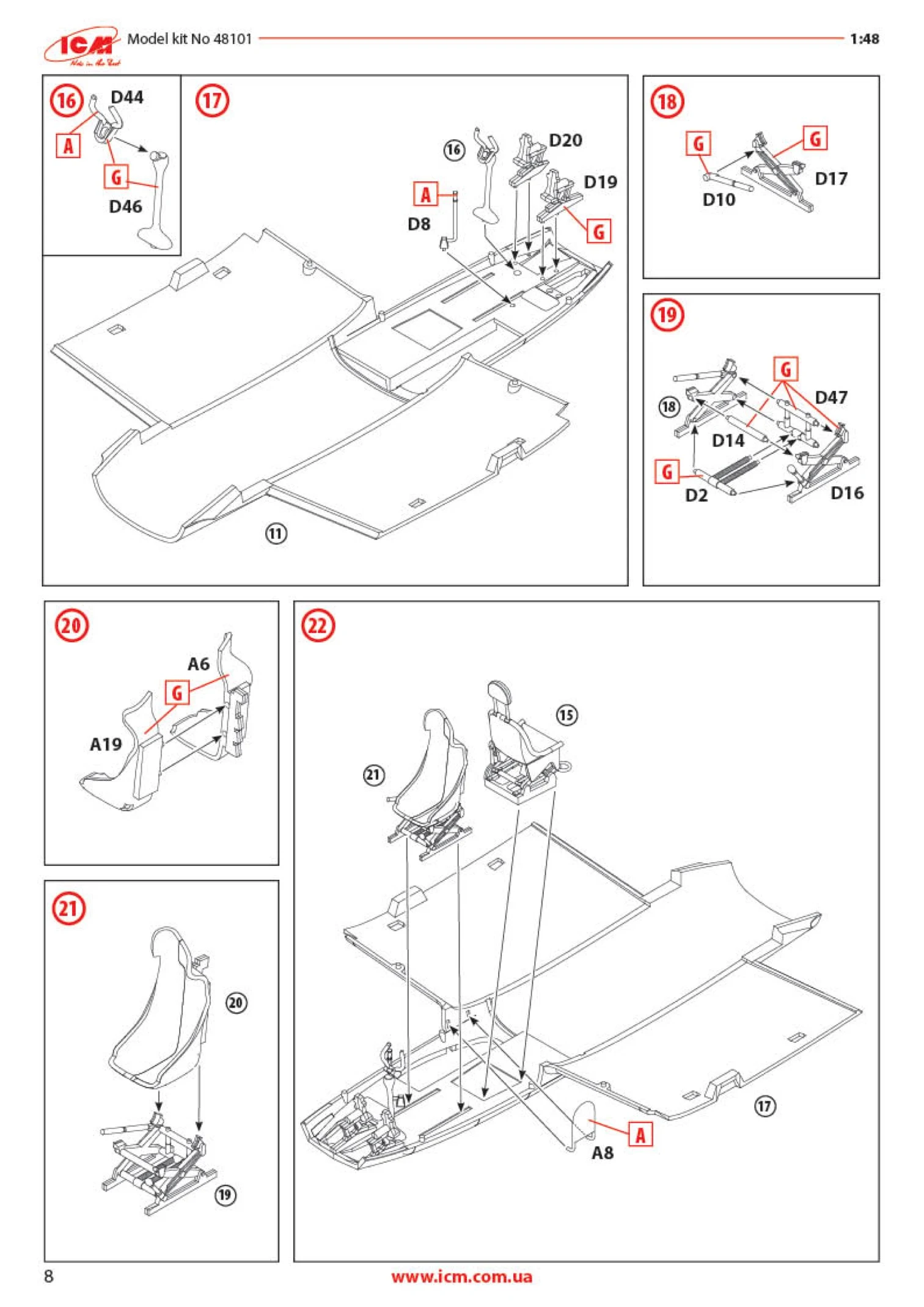Mistel S1 (German composite training aircraft)
From ICM
Kit No #48101
Two markings in the box
1/48th scale
Price: $87 USD on the Hobbylink Japan Website
The most successful of these used a modified Junkers Ju 88 bomber as the Mistel, with the entire nose-located crew compartment replaced by a specially designed nose filled with a large load of explosives, formed into a shaped charge. The upper component was a fighter aircraft, joined to the Mistel by struts. The combination would be flown to its target by a pilot in the fighter; then the unmanned bomber was released to hit its target and explode, leaving the fighter free to return to base. The first such composite aircraft flew in July 1943 and was promising enough to begin a programme by Luftwaffe test unit KG 200, code-named "Beethoven", eventually entering operational service.
There proved a slew of Mistletoe derivatives (some realized and others only planned) including the Bf 109F-4/Ju 88A-4 combination under the name of "Mistel 1". The Mistel S1 was to be its trainer platform as such a composite aircraft required specific training in the handling and release of the large payload. It is this combination that ICM have based their new "composite" kit on.
IN THE BOX - ICM 1:48 Mistel S1 (48101)
ICM have proven themselves to be quite adept at combining two (or more) kits from their extensive catalogue in order to form a simple "group" boxing (eg figures + aircraft) or in this case a completely different (and somewhat unique) subject.
In the box of this new Mistel S1 kit, we find two full aircraft kits. ICM's own 2006 tooled Bf 109F-4 and their newer 2016 tooled Ju88A-4. A separate small sprue contains the mounting frame used to join the Bf 109 and Ju 88 to each other to form the Mistel composite aircraft.
First up let's take a closer look at the Bf 109F-4 Huckepack ("Piggyback") aircraft. Being a 2006 tooling my expectations were not high and you can see pretty much straight away that the detail on the fuselage looks quite sharp but there is not a lot of it. Of course, it's not entirely fair to compare this kit with the likes of Eduard's newer 109 family, but as you will see shortly the quality of the ICM 109 goes downhill from here so you may find yourself considering a replacement.
ICM have proven themselves to be quite adept at combining two (or more) kits from their extensive catalogue in order to form a simple "group" boxing (eg figures + aircraft) or in this case a completely different (and somewhat unique) subject.
The finish on the upper wings looks to be about the same as the fuselage, that is to say, smooth and sharp. It's when we look at the lower wings that things start to turn nasty.
Zooming in on the lower wing, you can clearly see the surface has a very rough, almost "frosted" look to it. This is not a visual anomaly because running the tip of my finger over the surface I could easily feel the coarseness. Likewise, the panel line detail is imprecise and vague. As an example notice how the circles are not really circular, that is to say, they look more like a series of lines joined roughly together.
Likewise, the outer lower wing reveals many of the same surface issues and I believe would require some serious sanding and re-scribing to bring it up to standard. My comments may seem harsh but I know how good the Ju 88 tooling is in this kit so I think it's worth pointing out that the 109F-4 kit does not compare.
The Bf 109F-4 clear parts are nicely moulded and appear crystal clear and blemish-free. From the assembly instructions it appears that the canopy is not designed to be displayed open but given 109 canopies are hinged at the side it should not be hard to make that adjustment should you wish.
By modern standards, the ICM 109F-4 cockpit is pretty basic. If you choose to leave the canopy closed it probably won't be that big an issue, just keep it in mind when deciding open or closed.
As the original BF 109F-4 kit was never designed for retracted undercarriage, ICM have included a set of "dummy halves" for the main gear doors and wheels on sprue H. The need to do this clearly shows that the ICM kits main wheel wells are not deep enough in the first place. If you decide to have the gear extended then just use the parts from the original Bf 109F-4 sprues B & C rather than this new "wheels up" option.
The Donor Ju 88
For the Mistel itself, aka the larger unmanned component of this composite aircraft configuration, ICM have included their Ju88A-4 kit. Tooled in 2015, the ICM Ju 88 is easily the best offering in 1/48 with the only real competition being the much older (1993) vintage Dragon Ju 88 family. I previously undertook a detailed review of the ICM Ju 88D-1 and found it to be a truly excellent kit in all respects.The ICM Ju 88 kit sports many features straight out of the box such as full engine detailing with precision-tooled parts and finely recessed surface panel/rivet detail.
There is enough detail here for most modellers to use without enhancements
Like most medium bombers of WW2, the Ju 88 had a lot of glass in and around the crew compartment. I was most interested in how all these clear parts would fit. The good news is they fit like a glove. Literally, no gaps and they simply click into place. At the sight of all that masking, I also weakened and purchased the Eduard pre-cut masking set.The support bracing that joined the two aircraft together consisted of two main struts on either side of the fuselage-mounted into the wing roots. Additionally, a V brace was fitted between the two main struts and fixed to the top of the fuselage. For the fighter tail, a single thin strut was fixed just in front of the tailwheel.
To accommodate the various support braces, receiving holes need to drill at specific locations on the underside of the Bf 109 and upper side of the Ju 88 fuselage and wing roots. The ICM instructions are quite specific with measurements in millimetres supplied to be measured from specified datum points on the airframe.
Sprue H is provided separately from the two bagged aircraft kits in the box. All the parts that are specific to the Mistel S1 composite are on this sprue.
Close up wartime photos of the Mistel support frames show how control wires and fuel pipes (the 109 could use fuel from the Ju88 tanks) ran along the struts between the aircraft. ICM obviously provides non of this detail and the modeller will need to add themselves using wire and tape (should they so desire).
A final closeup of the support braces, including the included "wheel blank" which is designed to be used for a wheels-up configuration. Note that there seem to be plenty of period photos that show the undercarriage extended on the Huckepack ("Piggyback") aircraft, at least when on the ground.
COLOURS & MARKINGS - ICM 1:48 Mistel S1 (48101)
Markings are provided for two Mistel S1 options, both with essentially the same paint schemes as not a lot of variety existed on these training airframes. The prototype Mistel S1 ‘Beethoven’ combinations, used a Bf 109F-4 coupled with a Ju 88A-4. The combination proved favourable, with performance, control and functioning all acceptable.
Markings are provided for two Mistel S1 options, both with essentially the same paint schemes as not a lot of variety existed on these training airframes. The prototype Mistel S1 ‘Beethoven’ combinations, used a Bf 109F-4 coupled with a Ju 88A-4. The combination proved favourable, with performance, control and functioning all acceptable.
The decals for both aircraft are supplied on a single large sheet. ICM homegrown decals are known to perform well and from my examination of this sheet, I saw no blemishes or printing issues. Swastikas for the vertical tail are provided on the sheet broken into halves (as seems to be common these days).
CONCLUSION - ICM 1:48 Mistel S1 (48101)
Another interesting release from ICM, which cleverly makes use of two kits in their existing catalogue. As mentioned, the 109F-4 kit is really showing its age and IMO could ruin the overall impact of the finished model, especially as it's been paired with the much newer Ju 88A-4 kit.
I like that you could make a very nice model straight out of the box with this kit (if you were happy with the 109 provided). I also like that you could easily mix and match better kits (such as the Eduard 109F-4 Weekend boxing) with the ICM Ju 88 and produce a vastly superior result. Add to this some scratchbuilt boarding ladders and cabling/piping along the support framework and you have yourself a very interesting, and eye-catching, modelling project.
The kit seems to selling for around the US$87 mark which seems quite reasonable when you consider what's included in the box.
Another interesting release from ICM, which cleverly makes use of two kits in their existing catalogue. As mentioned, the 109F-4 kit is really showing its age and IMO could ruin the overall impact of the finished model, especially as it's been paired with the much newer Ju 88A-4 kit.
I like that you could make a very nice model straight out of the box with this kit (if you were happy with the 109 provided). I also like that you could easily mix and match better kits (such as the Eduard 109F-4 Weekend boxing) with the ICM Ju 88 and produce a vastly superior result. Add to this some scratchbuilt boarding ladders and cabling/piping along the support framework and you have yourself a very interesting, and eye-catching, modelling project.
The kit seems to selling for around the US$87 mark which seems quite reasonable when you consider what's included in the box.
Gary Wickham
ASSEMBLY INSTRUCTIONS - ICM 1:48 Mistel S1 (48101)
Many thanks to ICM plastic model kits for supplying the kit for Gary to review.
You can see more of Gary's Work on his ScaleSpot.com Website & his Facebook page.
ASSEMBLY INSTRUCTIONS - ICM 1:48 Mistel S1 (48101)



.jpg)
.jpg)
.jpg)
.jpg)




.jpg)
.jpg)
.jpg)
.jpg)


.jpg)
.jpg)


.jpg)
.jpg)
























